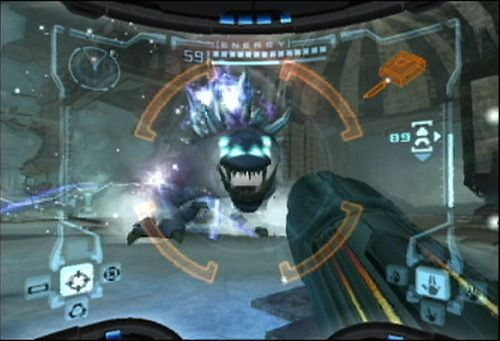- Get link
- X
- Other Apps
- Get link
- X
- Other Apps

Tunnel Vision
In a column called "Off With Their HUDs!" for the game-design site Gamasutra, Greg Wilson argues that losing the HUD helps increase the sense of immersion. "Nothing screams 'this is just a game' louder than an old-fashioned HUD," he writes. The fewer HUDs we see, the more we'll feel we're inside a holodeckian piece of cinema.Thanks to view from afar. Be sure to check out the Ambient Devices link in the story.
But me, I'm not so sure. I actually think our HUDs are a deeply impressive achievement -- gaming's contribution to the art of information delivery. The gaming HUD is not merely some ugly, artificial kluge. It's a triumph of data engineering.
After all, a good HUD allows you to juggle a ridiculously huge amount of information. Consider one of my favorite action-games, Ninja Gaiden. The HUD lets me monitor how much health I've got left, how relatively long my health bar is, how much ninja power I have left and how much health my boss-fight enemy has -- all while I'm frantically bouncing backward off the heads of my enemies.
This is a superhuman feat of concentration, people; it's about four times as much information as I process at my work desk, even on a good day.
In information-design circles, there's a phrase for what a good HUD delivers: "ambient information." Ambient info is designed so that it doesn't interrupt you. It's not like a pop-up window clamoring for your attention. Instead, ambient information floats in the periphery of your vision, like the dials on a car's dashboard. As ambient guru David Rose once told me, the information is "glanceable" -- you can keep abreast of it with so little mental effort you're not even aware you're paying attention.
That's why I believe HUDs don't hinder immersion -- they actually serve it. When I was playing the HUD-less King Kong, sure, it felt very "real life" to have no ammo bar. But I occasionally forgot how many bullets I had left. That confusion didn't take me deeper into the game experience: It yanked me out of it, like an irritating bug.
This is precisely the reason the Army is trying to create HUDs for combat soldiers. I know colonels who are avid gamers, and they've said that if they could slap a game-style HUD on every warrior -- complete with a list of their basic level of health, a map of their location and the status of their ammo and equipment -- it would undoubtedly save lives.
This is the paradox of immersion: By cleverly delivering a slew of artificial information, the HUD allows you to focus purely on what's most important. Sometimes, the best way to focus on your task at hand is by carefully lining your vision with ambient information. The less the soldiers have to pay attention to picayune details of their real-life situation, the more "present" they can be.
Indeed, many industries think game HUDs have it right. As our computers force us to juggle more and more programs simultaneously, software designers are trying to create HUD-like displays for e-mail, phone calls and instant messaging. Car manufacturers are experimenting with windshield HUDs that let drivers monitor their speed without taking their eyes off the road. The goal is to model real-life cars after the autos in Need for Speed -- not the reverse.
Of course, games being games, there are other good arguments for ditching the HUD. It might make life difficult for players, but hey -- that's fine so long as the game is also more fun. As Wilson points out, getting rid of the HUD can force game designers to be even more creative or dramatic in delivering information, such as with audio cues. I remember the first time I played Quake online, and could detect approaching enemies by their footfalls -- information that was both useful and creepily atmospheric.
Health bars and ammo counts may seem a bit cheesy, but they're also part of the lingua franca of gaming. They're even metaphors for our lives. A while ago, I saw a hipster walk into a bar in Manhattan wearing a T-shirt with a mock health bar showing how much "power" he had left. There's plenty of life in the old HUD yet.
Comments
Hehe, Metroid Prime. What a brilliant game that was.
ReplyDelete